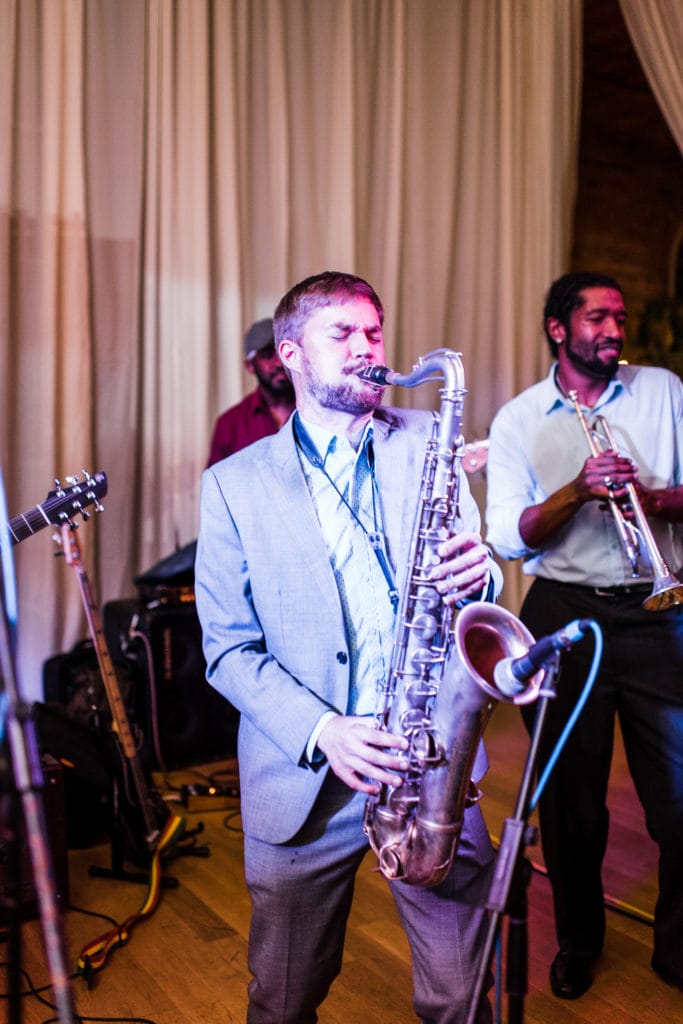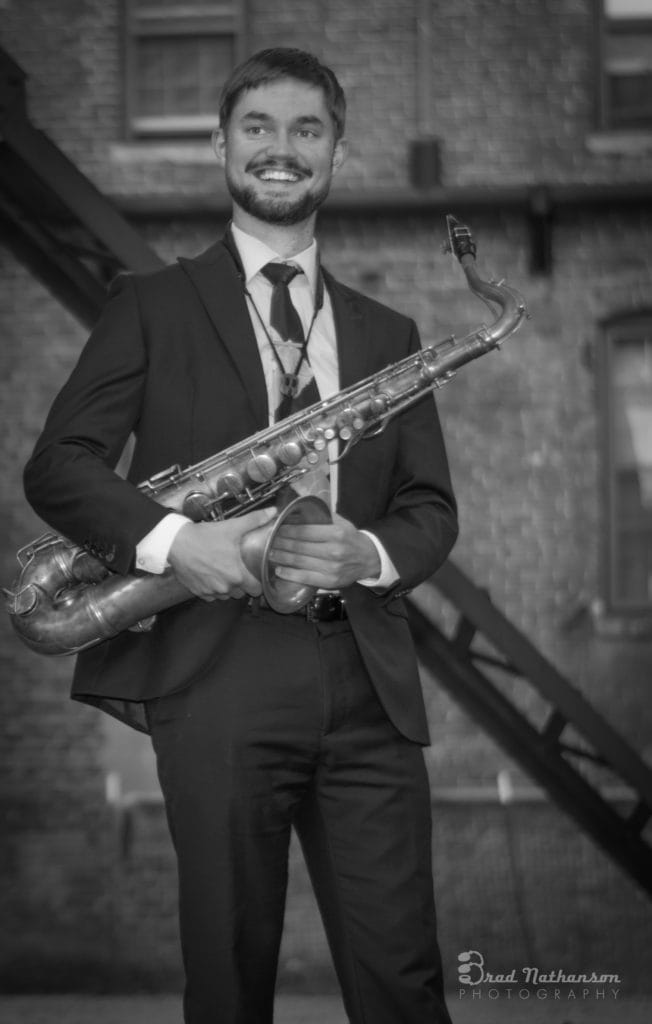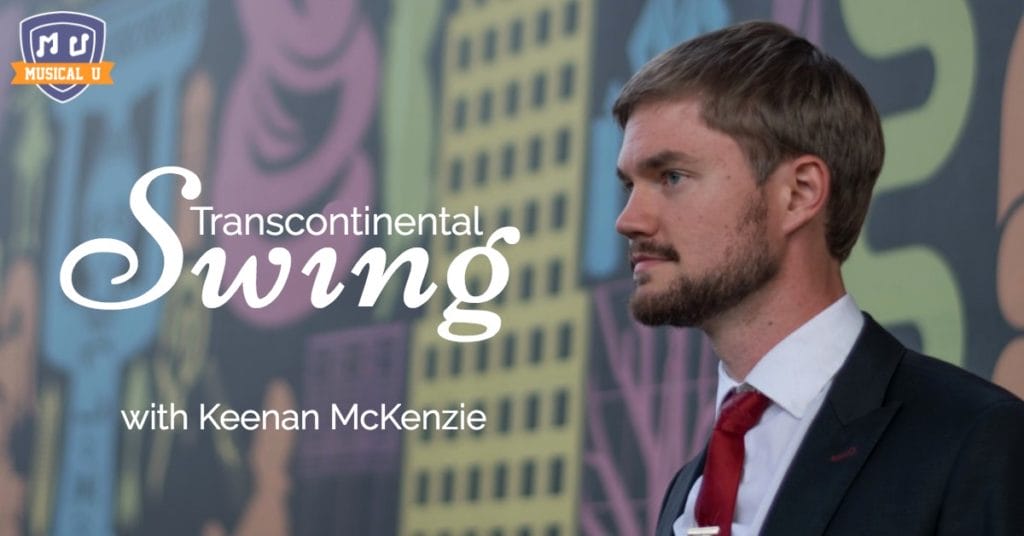In the 1930’s and 1940’s, popular music was swing music. With big horn-driven bands, a jubilant, vigorous and athletic dance, and a celebratory feel, swing music became a national craze in America, and from there was exported worldwide.
With the rise of rock, country, and R&B in the 1950s, the big bands began to take a back seat. Hard-core jazz fans turned to small combo sub-genres, like bebop and cool jazz.
But swing music and dance have enjoyed perennial revivals over the years, and as long as people love to dance, it looks like the trend will continue.
Some revival bands blend swing with modern genres (like electro-swing or Brian Setzer’s guitar-driven style), and some find a way to tune in to the 30s-40s style while maintaining their own individuality.
Multi-instrumentalist, composer, and educator Keenan McKenzie is definitely in the latter camp. Through his composing efforts and work with multiple swing bands, he has found a unique sound that both pays homage to the swing era greats and retains a timeless quality.
Musical U had the pleasure of interviewing Keenan on his distinctive swing sound, his latest release Forged in Rhythm and the incredible production process behind it, how he balances his life as a performer with his work as an educator, and the myriad of other genres he has explored throughout his remarkable career.
Q: Hi Keenan, and welcome to Musical U! How did your musical life begin?
Both my parents play music, so my musical life also started from year one. In fact, I was technically a recording artist at a very early age. My parents made an album of children’s music when my sister and I were toddlers, and it features our tiny voices on the sing-alongs! We also traveled with them on many gigs throughout our childhood. For me, formal musical education began with piano lessons in third grade, and later I played in the school band.
Q: Who are the McKenzies? Sounds like a family band!
Most of the time, “The McKenzies” refers to my parents, Woody and Marcia. As a duo, they play a mix of traditional and folk music, but they also write their own songs. When I join them, we typically play for contra dances, which are community line dances related to English country dancing. For those events, we play an eclectic mix of Appalachian, French-Canadian, Irish and ragtime music:
Q: I love contra dancing, and playing for contra dances as well. It’s fun to mix up all those Celtic-originated genres. It’s cool that you put ragtime in the mix.
There’s nothing quite like playing for people who love to dance! But you’ve taken it in a different direction with writing and performing for eighteen-piece swing jazz bands. How did you get into jazz?
When I was about five years old, my uncle Chris showed me a simplified boogie-woogie piano riff that I could play with two fingers. I thought it was the coolest thing! In elementary school, while the normal kids were listening to the current radio hits, I was listening to 1950s rock & roll. I think I really connected to any music that had a bluesy feel to it. Once I got a saxophone in middle school, I started picking up on the common threads between boogie-woogie piano, blues, and jazz.
Q: So your family has been a major musical influence…
My parents have played a huge role in shaping my musical sensibilities. Throughout most of my life, music was their second job. Even as I pursued university degrees, they provided an invaluable perspective from outside of the jazz scene. To this day, all the music ingrained in me from childhood has had some effect. Random fiddle tunes still get stuck in my head when I least expect it.
Without a doubt, my core sense of energy and rhythm comes from my parents. The title track of my album Forged in Rhythm is a nod to that idea!
Q: Who were your most influential teachers later on? Why?
I’ve had many great teachers over the years, but I’ll mention two specifically.
My high school band director, Brian Quakenbush, ran a jazz group that was heavily focused on theory and improvisation. He introduced me to many important concepts and created opportunities for me to cut my teeth as an improviser. He also arranged all sorts of music for the bands at the school, which encouraged me to explore composing as well.
When I was in college, Chad Eby was my primary mentor, and is largely responsible for me checking out old-school jazz players. He opened my ears to countless great recordings, and always knew the perfect solo for me to transcribe next. As a teacher, he was incisive, honest and always fully invested in my success.
Q: While you are into many projects, your swing thing is really taking off. How did you become involved in swing?
I first attended a swing dance during a summer program in high school. In college, I continued dancing casually, but eventually took some classes in Lindy Hop. Around that time, I also started a jazz combo with a singer, and it was a natural progression to start playing for the local dances.
In grad school, I joined the Mint Julep Jazz band, which helped connect me with the larger scene. The swing dance community is strong as ever these days, supporting multiple traveling events most weekends of the year and all over the world!
Q: Fantastic! What is the difference between playing swing (for dancing and otherwise) and the combo/concert jazz that has been dominant for at least the last 60 years?
This topic could easily become an entire article! When playing for swing dancers, you generally want a strong 4/4 pulse in the rhythm section. There is evidence that the walking bass line evolved alongside the Lindy Hop (whereas the two-beat feel of 1920s jazz fits well with the Charleston).
For the drums, you’ll want to use plenty of hi-hat and brushes as opposed to hitting the ride cymbal. It’s also great to have a guitar chunking quarter notes à la Freddie Green:
Overall, the rhythmic placement is a bit more on top of the beat than later styles. Even though you swing the eighth notes, you don’t want to “lay back” too much. Two-bar riffs are great, as they emphasize common phrasing elements in the dance. You also want to avoid extreme tempos and stick to three- or four-minute arrangements, so improvisers have to be economical with their solos.
The song length is largely an artifact of what could fit on a 78 rpm record, but it has become an expectation at modern dances. The best thing to do is listen critically to swing-era recordings. You can find playlists online published by swing DJs – that’s a great place to start.
Q: Well it’s obvious from your playing that you’ve done your homework. Much to my delight, I hear the soulfulness of one of my favorites Ben Webster (as well as Lester Young and Coleman Hawkins) in your swing playing. Is this just wishful thinking, or is there something to that?
Wow, that’s so flattering to hear! All of those guys are my heroes. I have transcribed Ben Webster solos before, although I’ve probably studied more Lester Young over the years.
”There is a place for virtuosity, but it should always serve a musical purpose and not just be an exercise in ego.”
In different musical moments, I find myself wanting to channel different players. I could probably find spots on the album where I clearly borrowed something from Ben Webster. Other times, it may be more abstract.
For “Pres,” I had Lester Young’s 1930s dates with Count Basie in my ear, more so than his more introspective recordings. In preparing for this project, I also listened to a bunch of Illinois Jacquet and Chu Berry. When you dig in deep into a player’s sound and style, it eventually blends in with your own personality and everyone else you have checked out. It is super cool to find out what others hear and recognize in your playing!
Q: I especially appreciate your restraint – your willingness to sacrifice the virtuosic display that is so characteristic of the prevailing “jazz macho” aesthetic in service to the melody. How did you come to this priority in your soloing?
Excessive flurries of notes have never been my thing, and I think a dance album is probably the last place they belong! That said, I believe there is a place for virtuosity, but it should always serve a musical purpose and not just be an exercise in ego.
The swing-era saxophonists always had a great sense of melody, but one player I always come back to is Sonny Rollins. When you hear him improvise, you get killer lines juxtaposed with the most singable and inspired ideas. Cannonball Adderley is another great example of phenomenal chops that are tempered by musical taste and a deference for melody:
It’s also critical to actively listen to the rest of the band when you are soloing. You are just one part of what is happening on stage, and the rest of the band will enjoy playing with you if you are truly playing with them, and not just over the top of them.
Q: So true – understanding your role in a band setting and playing in a way that is mindful of your bandmates is so important!
We are absolutely thrilled with your latest release Forged in Rhythm, and surprised that you penned the music and lyrics of the delightful “classics” on the album. How did you begin writing songs? How do you write songs that sound so authentically swing-era?

Photo by A. J. Dunlop Photography
I have been writing music for much longer, but first tried my hand at lyrics in high school. I think I was at least 22 before I wrote something I’d want anybody to hear now.
Concerning melodies and harmony, I suppose I have studied enough old recordings that I can often tell when something sounds anachronistic. For the lyrics, I chose to avoid specific lingo from the time period and go for a more “timeless” sound. I think a lot of material from the Great American Songbook has this feeling.
Many songs grew out of a single phrase, but I also tried to explore writing from the perspective of different characters. Many jazz standards originated in theater shows, and it adds an interesting dimension to a composition if you envision a scene surrounding it! I was also lucky to have Laura Windley on vocals and a band full of musicians who play authentically in the style.
Q: It shows – your music and lyrics manage to maintain a great classic feel without ever sounding cliché.
Beyond the writing, the band really swings! How did you achieve that feel? What role does playing for dancers have?
While the recording session for Forged in Rhythm lasted a single weekend, we had prior experience playing together and were all on the same page with the style.
Jonathan Stout (guitar) and Josh Collazo (drums) run their own groups based in Los Angeles. Gordon Au (trumpet) runs a band in New York. Lucian Cobb (trombone) and Laura Windley (vocals) are the co-leaders of the Mint Julep Jazz Band in North Carolina. Many of us have played with Michael Gamble and the Rhythm Serenaders, and previously recorded together.
These are all premier musicians in the dance community, so I trusted everyone’s expertise and tried not to micromanage.
Q: I understand the production of your album was truly “transcontinental” – with various components taking place in L.A., Seattle, and North Carolina. Tell us more about that experience.
All of the composing and preparations were done back home in North Carolina. When it came to the recording weekend in L.A., I think I was taking a bit of a risk. I had invested a lot in the project already, and we had only scheduled two days to record.
Fortunately, all the flights were on time and there were no logistical disasters. We recorded in a cool little studio called Grandma’s Dojo, run by Miles Senzaki. We played about two or three takes of each tune, only rehearsing a few select passages. We even played a show in Pasadena after the first day – which may have been a bit much!
When I got back home, I had a local engineer, Jason Richmond, do the final mixing. It was finally sent off to be mastered by Steve Turnidge in Seattle. Looking back, I’m not sure if this is how I will record my next album, but it was a really special experience with a bunch of talented people!
Q: There’s nothing more magical than what happens when the great musicians come together in the right place at the right time.
Besides having composing, arranging, and recording Forged in Rhythm, you’re active in a variety of other projects and performances. Tell us more about that.
Probably the most significant is a band called The Shakedown, which began as a wedding band, but has turned into something much more.
A few years ago, we began a series of tribute shows to keep things interesting and fresh. So far, we have performed entire nights of Van Morrison, Sam Cooke, Ray Charles, Bob Marley, Frank Sinatra, Prince and more.
I’m usually tasked with arranging the horn parts and helping to direct rehearsals. The band is composed of some of the most talented folks in my area, and I feel incredibly lucky to play such a range of music in one group.
Q: Apart from your busy live performance schedule, you maintain a docket of private students. How does teaching figure in to your musical growth?
Teaching keeps me honest with my own playing, partly because I want to set a good example for my students with my technique and habits. Beyond that, when you explain a concept to somebody else, it forces you to think about it from multiple angles and consider it independent of your personal experiences and biases. Educating others has refined my own understanding, and students often introduce me to new songs and artists.
Q: At Musical U, we promote the inner musical skills – such as ear training, playing by ear and improvisation – that help people become confident, well-rounded musicians. What role has ear training had in your training, and have now in your teaching?

Photo by Brad Nathanson
It is wonderful that you emphasize aural skills! Regardless of genre, learning by ear is a huge part of the equation.
I made the largest strides in my jazz playing when I started learning improvised solos by ear. Learning off a recording helps you memorize the notes, but you also internalize the tone, articulation, rhythm, dynamics, and much more.
There are so many subtle aspects of music that we don’t have a visual notation for!
A developed ear is critical for improvisation, and everyone can benefit from some experience with the spontaneous. When I’m teaching, aural skills can help introduce a new song that’s not in the book, or transpose a song on the spot so I can accompany a student on the piano.
Q: Very true – aural skills benefit the teacher as much as they do the student. What is your advice – both musically and career-wise – to the aspiring musicians in our audience?
If you are pursuing music as a career, know that there are many paths it can take. I currently make my living with a mix of performing, teaching, arranging, and composing. Unless you are playing to sold-out crowds in massive venues, you may need to embrace a variety of opportunities and wear many hats.
For everyone: seek out great mentors and collaborators, and accept weaknesses as opportunities for improvement. In my experience, hard work and perseverance eventually matter more than innate talent. Music is a lifelong journey, but each new challenge is what keeps it interesting!
Q: That’s some very grounding and realistic yet optimistic advice. Keenan, thank you so much for sharing your insights on collaboration, swing music, and the benefits of ear training. We look forward to your next release! Please keep us in the loop on your new projects.
Revitalizing Music
As the popularity of styles fades and resurges, there will always be musicians doing the work of revival: taking cues from the classics, and paying homage to the greats.
Is there a style of music from an era long-past that speaks to you? You’re likely not the only one! Whether you want to play the classic Delta blues or emulate the sound of early electronic acts such as Kraftwerk, chances are, there’s a community of musicians out there doing something very similar, just like the swing music and dance scene that Keenan became a part of.
Find fellow musicians with similar musical sensibilities, and bring back the oldies – whether in a contemporary way, or an original, traditional style à la Keenan. Looking for more “swingspiration”? More info on Keenan’s arranging, composing, and teaching? You can find the many facets of Keenan McKenzie on his website and Facebook page.
Featured Image of Keenan McKenzie courtesy of Brad Nathanson Photography.







